Environmental Monitoring and Real-Time Data
| Research Program
The System-Wide Monitoring Program (SWMP) uses standardized protocols and instrumentation across the national network of NERR sites. The standardized approach and resulting long-term data sets provide the capacity to evaluate changes in estuarine ecosystems in response to natural and anthropogenic disturbances at a variety of temporal scales and from a local to national perspective.
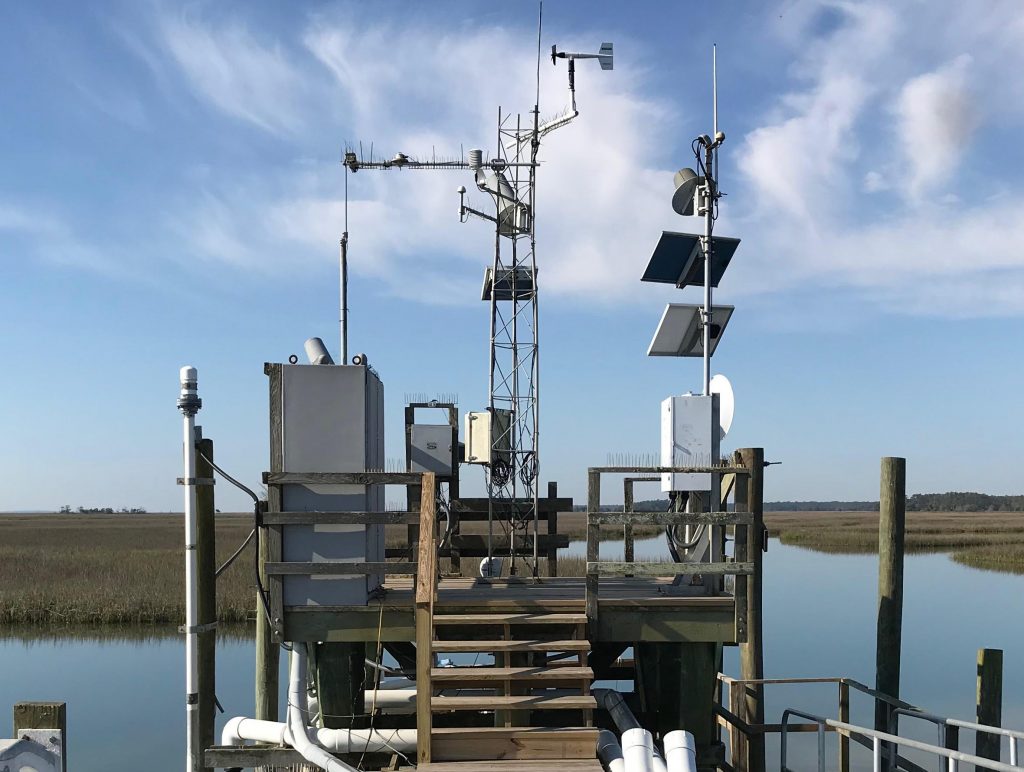
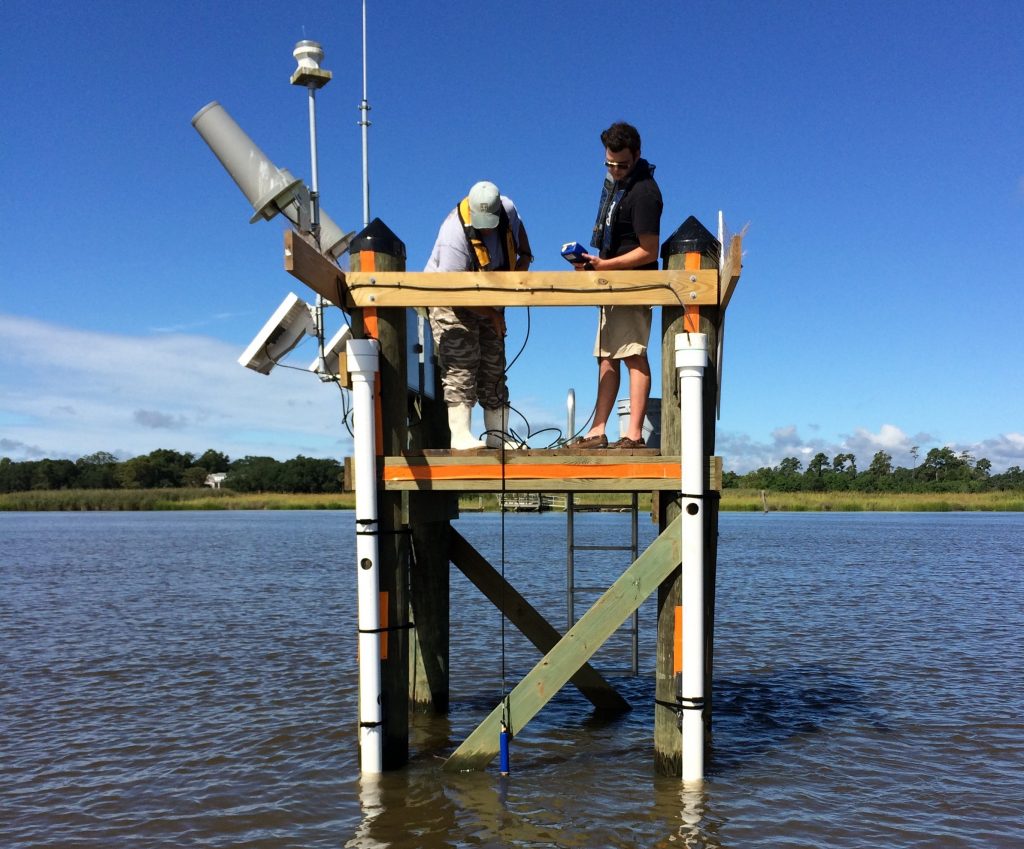
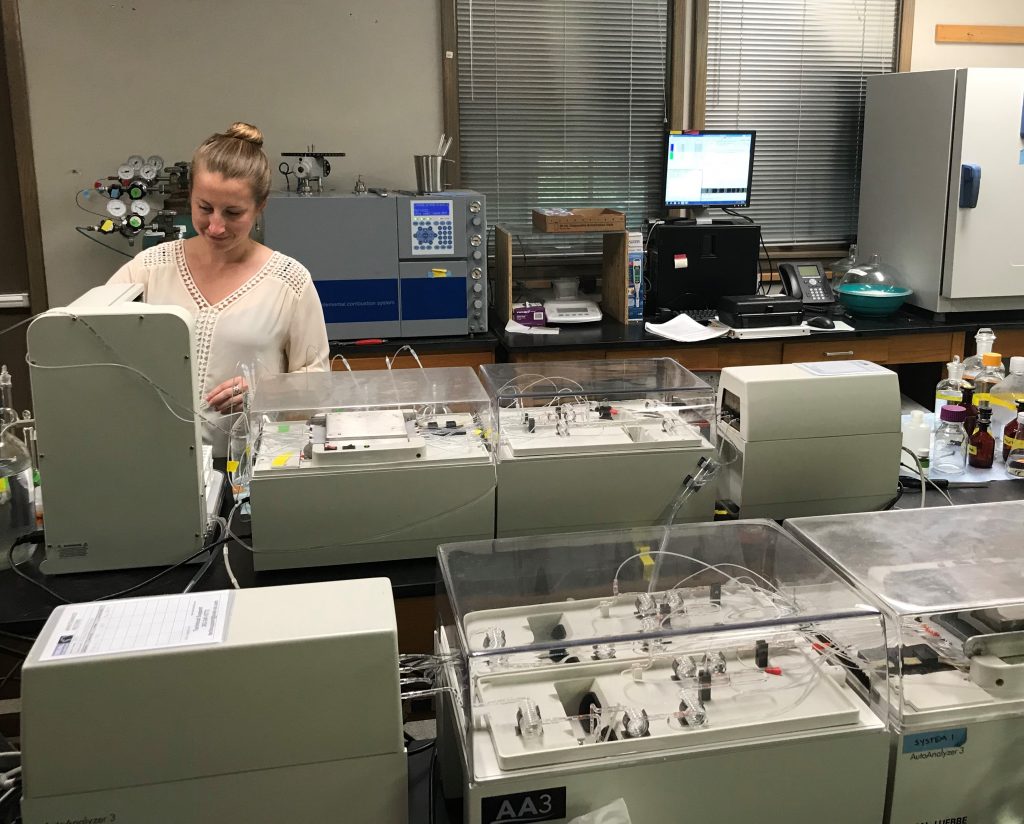
Components of SWMP
Meteorological data are collected at a single automated weather station in North Inlet. Data parameters measured include: wind speed and direction; air temperature; barometric pressure; relative humidity; rainfall; photosynthetically active radiation; and total short-wave solar radiation. Data are measured every 5 seconds and collected as 15 minute averages. All 15 minute data are transmitted via NOAA satellite on an hourly basis to the NERRS Centralized Data Management Office to provide near real-time data accessibility.
Water quality data are collected at 6 permanent sampling stations within North Inlet and Winyah Bay using automated and continuously deployed YSI EXO2 data sondes. Data parameters measured include: water temperature; specific conductivity; salinity; dissolved oxygen; pH, turbidity, and water level. At select locations, measures of chlorophyll fluorescence and fluorescent dissolved organic matter are also collected. Data are automatically collected every 15 minutes and, at most stations, transmitted via NOAA satellite on an hourly basis to the NERRS Centralized Data Management Office to provide near real-time data accessibility. These parameters represent important indicators of physical conditions and habitat quality for numerous estuarine species.
Nutrient and chlorophyll data are measured every 20 days from discrete water samples collected at 4 of the water quality monitoring stations in North Inlet and Winyah Bay. Nutrient parameters analyzed include: dissolved inorganic nitrogen and phosphorus (NH4, NO2, NO3, PO4) as well as total nitrogen and total phosphorus concentrations. In addition to chlorophyll analysis, water samples are analyzed for concentrations of total and volatile suspended solids and dissolved organic carbon at select locations. These parameters collectively provide essential information on nutrient enrichment and eutrophication in estuarine waters. These data are available on a yearly basis from the NERRS Centralized Data Management Office.
SWMP Sampling Sites
Three of the reserve’s SWMP sites are located in the North Inlet estuary, an ocean-dominated bar-built estuary, which contains numerous winding tidal creeks that drain extensive Spartina alterniflora (now Sporobolus alterniflorus). The system is considered relatively pristine due to minimal anthropogenic impacts and rapid exchange with the ocean. The watershed drains a 24.8 km2 area of mostly pine forest and a moderately developed residential area to the north. The remaining two SWMP sites are located in the Winyah Bay estuary, a classic drowned-river valley estuary that has its headwaters in the Blue Ridge Mountains of North Carolina. Its watershed consists of the sub-basins on 5 major rivers, which collectively represent a cumulative area of 47,060 km2, making it the 3rd largest watershed on the Eastern Seaboard. As a result of extensive agriculture, residential development and industry in the watershed, Winyah Bay is considered a relatively impacted salt-wedge estuary. The two estuaries are connected by a pair of subtidal creeks that provide exchange and passage between the two estuaries, although the presence of strong tidal nodes in these creeks largely limits the mixing of each estuary’s distinct water mass.

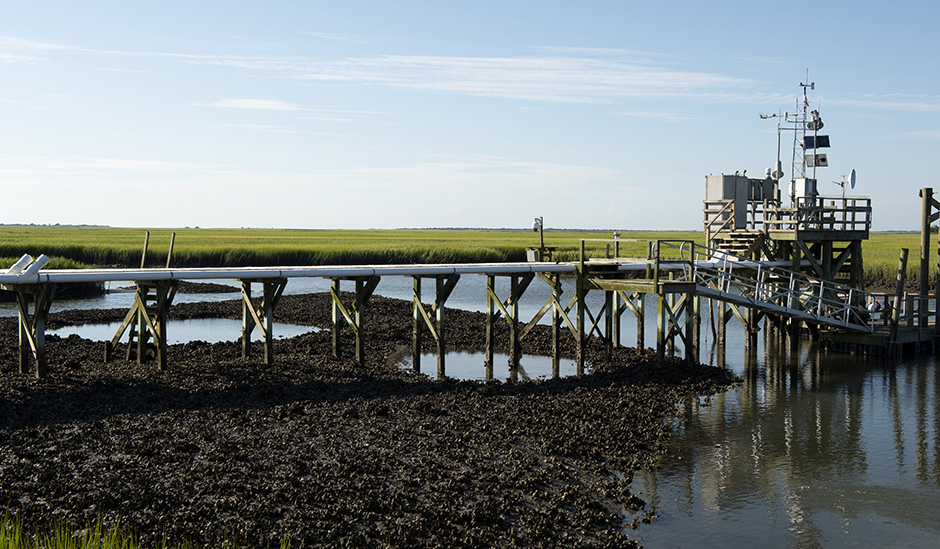
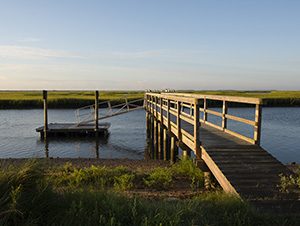 lat 33°20’02.05” N, long 79°11’34.62” W
lat 33°20’02.05” N, long 79°11’34.62” W
The Clambank Landing monitoring site is located roughly in the center of the reserve boundary. This site is surrounded by a Spartina alterniflora marsh and does not drain a defined sub-basin of the North Inlet estuary (as is the case for Crabhaul and Debidue Creeks). It is predominantly influenced by oceanic waters due to its close proximity to North Inlet, but is occasionally influenced by water entering from Winyah Bay at the creek’s southern end. Salinity has ranged from 5 to 39, with a long-term average of 33. This site is considered relatively pristine and is influenced by its close proximity to the Inlet mouth. Water quality, nutrient and chlorophyll monitoring was initiated at this site in 2001.
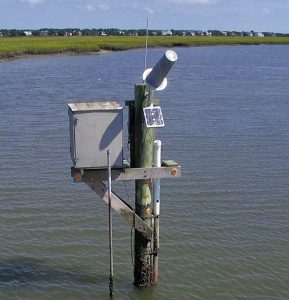 lat 33°21’36.49” N, long 79°10’02.81” W
lat 33°21’36.49” N, long 79°10’02.81” W
The Debidue Creek monitoring site is located in an ocean-dominated Spartina marsh that was formerly surrounded by pine-dominated uplands. The site is approximately 1 km south of the Debordieu Colony, a large development built on man-made canals that drain into the northern portion of Debidue Creek, and as a result, may be considered an anthropogenically impacted site. Salinity has ranged from 0 to 36 with a long-term average of 33. Water quality, nutrient and chlorophyll monitoring was initiated at this site in 1998.
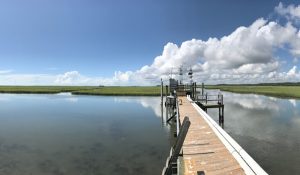 lat. 33°20’57.70” N, long. 79°11’19.97” W
lat. 33°20’57.70” N, long. 79°11’19.97” W
The Oyster Landing monitoring site is located near the western, upland edge of the North Inlet basin, at the confluence of two 1st order tidal creeks: the upper reaches of Crabhaul Creek and a much smaller un-named creek that directly drains pine forested uplands and wetlands. The sampling site is approximately 2.8 km from the terminus of Crabhaul Creek. The vegetation of the Crabhaul Creek sub-basin is dominated by Spartina alterniflora that transitions into salt pan, Juncus roemerianus and mixed vegetation communities along its upland edge. At the monitoring site the creek has an average depth of approximately 2m at MHW. The average tidal range is about 1.4 m. Salinity has ranged from 0 – 39, with a long-term average of 32. The site is considered to represent relatively pristine conditions due to the absence of significant disturbance in its drainage area. Water quality, nutrient and chlorophyll monitoring was initiated at this site in 1993. This is also the site of the NERR’s meteorological station.
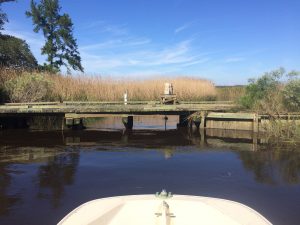 lat. 33°17’57.03” N, long. 79°15’21.75” W
lat. 33°17’57.03” N, long. 79°15’21.75” W
The Thousand Acre monitoring site is located approximately 15 m from the mouth of a creek that drains a tidal brackish marsh that empties into the northeastern side of the mid-portion of Winyah Bay. The marsh, which is now dominated by brackish plants such as Spartina cynosuroides was formerly impounded for rice cultivation. Rice cultivation was abandoned prior to the Civil War. The upland drainage consists of undeveloped pine forest and forested wetlands. At the monitoring site, the creek depth is approximately 2 m at MHW with an average tidal range of approximately 1 m. Salinity has ranged from 0 to 33, with a long-term average of 8.5. While the creek drains marsh and undeveloped uplands on ebb tides, it receives degraded Winyah Bay water on flood tides and is therefore considered an impacted site. Water quality, nutrient and chlorophyll monitoring was initiated at this site in 1993.
 lat. 33°18’33.88” N, long. 79°17’19.57” W and lat. 33°18’33.94” N, long. 79°17’19.58” W respectively
lat. 33°18’33.88” N, long. 79°17’19.57” W and lat. 33°18’33.94” N, long. 79°17’19.58” W respectively
The Winyah Bay monitoring site has both a surface water sonde (WS) and a bottom water sonde (WB). The site is located in the mainstem portion of Winyah Bay, on the western edge of the natural channel adjacent to Frazier Point Bend. This is roughly 6 km down-bay of the confluence of the Black, Pee Dee and Waccamaw rivers and 4 km down-bay of the mouth of the Sampit River and the City of Georgetown. This monitoring station is located to represent the collective inputs to Winyah Bay from its anthropogenically-impacted watershed. Water depth at the station is on the order of 5 m at MLW. Tidal range is approximately 1 m and the site exhibits salinity stratification, especially on flooding tides. The sondes are maintained at fixed depths of approximately 0.2 m below the surface at MLW (WS) and approximately 1 m above the sediment surface (WB). As water quality monitoring was only initiated at this site in May of 2016, long-term average salinities and tidal datums have not yet been established.
Sign Up for the latest news and events
Find out what’s going on at the Reserve with our monthly e-news letter.
Research Program Pages
Latest Research Program News

Storm Story: Hurricane Ian
Storm Stories use Data to Communicate Hurricane Impacts Storm Stories was developed through a NERR Science Collaborative Transfer Grant. The past several years of extreme
Research Program Contact
843-904-9026


